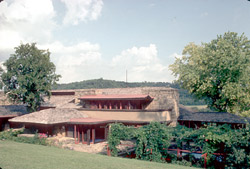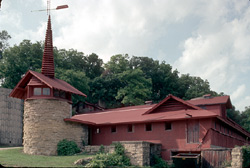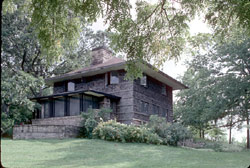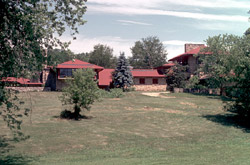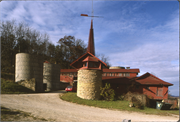2 mi. S of Spring Green on STH 23
| Historic Name: | Taliesin |
|---|---|
| Reference Number: | 73000081 |
| Location (Address): | 2 mi. S of Spring Green on STH 23 |
|---|---|
| County: | Iowa |
| City/Village: | |
| Township: | Wyoming |
| Taliesin STH 23, Town of Wyoming, Iowa County Architect: Frank Lloyd Wright In 1911, Frank Lloyd Wright began his home, Taliesin, outside Spring Green, Wisconsin. Taliesin, a Welsh word meaning "shining brow," acknowledges its perch on the brow of a stately hill. This hill captivated Wright as a teenager working on the surrounding farms of his Welsh maternal relatives, the Lloyd-Jones'. Wright intended Taliesin to be a home, studio and farm for himself and his mistress, Mamah Borthwick. Over time, Wright amassed the surrounding buildings and land, creating his Taliesin estate. Today the estate totals 600 acres with five Wright-designed structures, and a Wright-designed waterfall. Two of Wright's buildings stand within sight of his home: "Romeo and Juliet" and Tan-y-Deri. Wright designed Romeo and Juliet in 1886 as a windmill tower to pump water to his aunts' co-educational Hillside Home School. The wooden tower's daring design has no internal support, but is comprised of two interlocking forms that inspired its name. Romeo, a diamond, protects Juliet from the southwesterly winds. Juliet, an octagon, embraces and supports Romeo. Tan-y-deri, a 1907 home commissioned by Wright's sister and brother-in-law, sits in the shadow of Romeo and Juliet. Tan-y-deri is also Welsh, translating as "Under the Oaks," reflecting its setting among mature oaks. Further down the hill is Hillside School, another Wright building commissioned by his aunts. Built in 1902-3, Hillside is T-shaped with walls of sandstone, beige stucco and broad, protective roofs. Hillside includes an assembly hall supported by the corners, instead of the outer walls. Wright said later that the Hillside Home School helped him to "break the box" of architecture. The Taliesin estate also contains Wright's Midway Barns, a farm complex that clings to a prominent hill. Wright employed the newest farming techniques at Midway Barns, which became the agricultural center of the estate from the 1930s until his death. Taliesin was Wright's sketchbook. Its importance lies in Wright's constant structural and spatial experimentation on both buildings and landscape. Wright changed Taliesin whenever he wanted, particularly after he founded the Taliesin Fellowship with his third wife, Olgivanna, in 1932. Mr. Wright and Mrs. Wright created the Fellowship as an architectural and artistic community, teaching the apprentices to "learn by doing." Under Wright's direction, his apprentices added a 5,000 sq. foot drafting studio to the Hillside Home School, remodeled the original Hillside gym into a theater, expanded Midway Barns, planted or removed trees and reshaped the estate's pond, and made scores of changes to the Taliesin residence. Additionally, several fires forced Wright to make changes at the Taliesin estate. Two fires destroyed the living quarters of the Taliesin residence. On August 15, 1914, one of Wright's servants set fire to the building and murdered seven people, including Borthwick, while Wright was working in Chicago. The second fire, on April 22, 1925, was likely caused by electrical problems. Wright redesigned and rebuilt Taliesin each time. And finally, on April 26, 1952, a fire consumed one wing of the Hillside structure, allowing Wright to redesign its dining room and theater. Today, the Frank Lloyd Wright Foundation owns the Taliesin estate. The Taliesin Fellowship, under the auspices of the Foundation, uses the estate as its summer residence. Tours at the Taliesin estate are run by Taliesin Preservation, Inc., a separate organization. Tours are offered seasonally. |
| Period of Significance: | 1902-1938 |
|---|---|
| Area of Significance: | Architecture |
| Area of Significance: | Education |
| Area of Significance: | Landscape Architecture |
| Applicable Criteria: | Event |
| Applicable Criteria: | Architecture/Engineering |
| Historic Use: | Domestic: Single Dwelling |
| Historic Use: | Commerce/Trade: Professional |
| Historic Use: | Education: School |
| Historic Use: | Education: Educational Related Housing |
| Architectural Style: | Prairie School |
| Resource Type: | District |
| Architect: | Wright,Frank Lloyd |
| Historic Status: | Listed in the National Register |
|---|---|
| Historic Status: | Listed in the State Register |
| Historic Status: | National Historic Landmark Status Granted |
| National Register Listing Date: | 04/14/1973 |
| State Register Listing Date: | 01/01/1989 |
| Number of Contributing Buildings: | 5 |
|---|---|
| Number of Contributing Sites: | 1 |
| Number of Contributing Structures: | 3 |
| Number of Contributing Objects: | 0 |
| Number of Non-Contributing Sites: | 1 |
| Number of Non-Contributing Structures: | 3 |
| Number of Non-Contributing Objects: | 0 |
| National Register and State Register of Historic Places, State Historic Preservation Office, Wisconsin Historical Society, Madison, Wisconsin |

